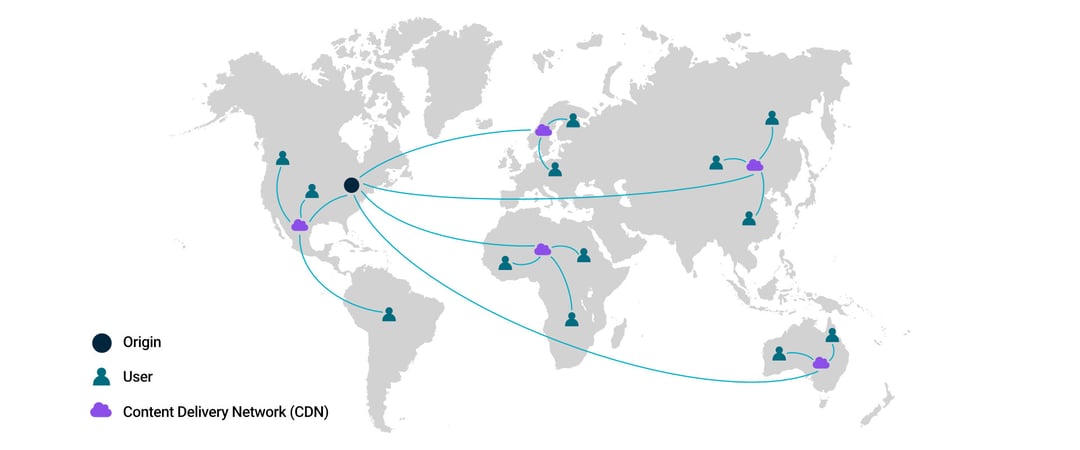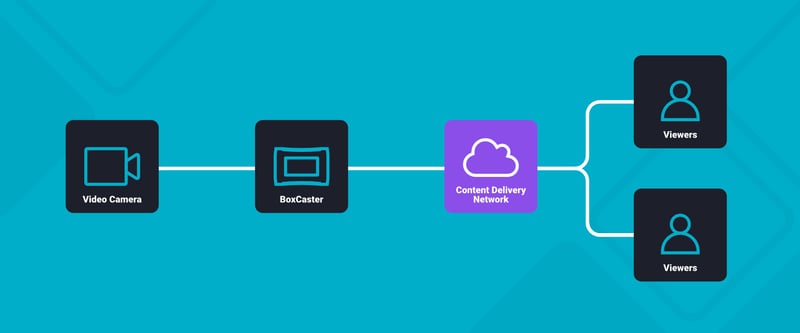VIDEO
Products
Streaming
Deliver flawless live video to any audience, anywhere
OTT Apps
Launch and monetize your own branded TV & mobile apps
Spark Encoder
Tap into hardware encoding that's compact and powerful
Broadcaster App
Go live straight from your phone or tablet with studio-quality control
Features
BoxCast Flow
Ensures smooth playback even on shaky networks
Sharing
Instantly clip, share, and amplify your broadcasts
Producer
Create professional streams right from your browser
Third-Party Encoders
Use the gear you love with our support of RTMP and SRT
AUDIO
RemoteMix
Mix live audio remotely from anywhere in the world
Compatible Mixers
Connect your favorite digital mixer to RemoteMix
INDUSTRIES
House of Worship
Reach and engage your congregation wherever they worship
Sports
Stream games with professional quality for fans everywhere
Local Government
Bring transparency and connection to your community broadcasts
Business
Power your corporate events, webinars, and live streams
LEARN
Blog
Insights, trends, and tips for the audio/video community
Tech Tips
Quick how-tos and deep dives on the latest streaming technology
Guides
Essential tips and expert strategies to expand your reach
Newsletter
Stay up to date with product news, best practices, and more
Podcast
Hear stories and strategies from our customers and experts
DISCOVER
Customer Stories
Explore real-world success stories to inspire your organization
Events
Join us at an upcoming conference and meet with our team
Webinars
Get all the details and register for our next live webinar
About Us
Discover our company's mission, values, and team story
Broadcasting, Live Streaming by Industry, Live Streaming Destinations, Live Streaming Software

BoxCast Team • October 21, 2022
Live streaming has revolutionized the way we consume media across the world. As a result of so many users accessing, uploading, and exploring the limitless amounts of content out there, streaming servers can become strained. That's why CDNs were created.
With a Content Delivery Network, or CDN, broadcasters are able to reach their audiences closer to where they live, cutting down on transit time and server stress.
In simple terms, a CDN is a network of edge servers placed optimally around the globe to answer any server requests and provide desired content.
We've all been here: You make a snack, have a seat, and are ready to watch your favorite video. Quick as a click, it's there on your screen for you to enjoy at your leisure.
Ever wonder how that content gets to you so fast? Didn't the internet used to be a battle for attrition against endless load times and latency? When did the internet get so fast?

Thanks to new strides in technology like Content Distribution Networks (CDNs), the pathways to deliver high-quality content to users have been streamlined to ensure a fast, stable connection for on-demand streaming. This is a major contributing factor to how high-quality 4K video and other media get to your home TV, computer, or phone — without taking forever to load.
In the old days, every request would be sent to the main server, which housed all the content libraries. That request could come from nearly anywhere, and could transit across the globe before your first frame had buffered. A CDN acts as a midway point between the main server and the user requesting content. The actual transit route is far shorter, since the request is redirected to the nearest local server.
The main infrastructure of a CDN consists of origin and edge servers, and the various nodes which connect them. An origin server is the primary housing server from which all requests for your content are answered. The content is pushed or pulled from the origin server and then placed on the edge nodes to await delivery requests. These servers are monitored by control nodes, which act as administrative tools and may even have additional security built in.
Delivery nodes are the real magic of a CDN. Using strategic placement, edge nodes can be situated geographically among your user population for best effect. These nodes work together with origin servers to answer user requests for content. The closer they are to the user making the request, the faster the data will reach them.

Larger CDNs will also have storage nodes. These are a key way to minimize transit time, as these nodes can house content data until it’s needed. They operate as smaller, less capable origin servers from which your edge servers can acquire the content.
But how does it do all of this so quickly and effectively?
The streaming protocols used by a CDN are far more advanced than older methods of data transference. Modern CDNs use HLS and MPEG-DASH to segment videos into small chunks, each lasting a few seconds. These chunks are what get pulled when content is requested.
Segmenting the files this way allows for a steadier stream, as each chunk can be uploaded much faster than the entire file as one piece. This reduces buffering time throughout the video — HLS streaming is even capable of detecting the optimal quality for your video. Users can still manually adjust quality settings if they want. This is made even easier if you're using a live streaming platform like BoxCast, which includes built-in features to adjust video quality and delivers your content to viewers automatically.

CDNs have redundancies to keep your stream running in high quality. Copies of media files are left on the server and cached, so the next request can just pull these cached files for even faster delivery.
This caching feature can be extremely useful to live streamers. Depending on the nature of your stream, you and/or your viewers may not have a perfect internet connection, so some of your broadcast may be lost due to buffering.
With CDN's content caching, those moments are still captured and can be played back as desired by anyone who misses it in real time.
In addition to distributing your content, you can get even more benefits than a traditional CDN would deliver by using BoxCast’s live streaming platform. Scale your production, adjust quality and distribute content to your viewers regardless of their connection speed with BoxCast’s streaming protocol. Start streaming now with BoxCast for free.
There are different types of CDNs available — each offers different things. Depending on the size and scope of your broadcast, you'll want to choose the CDN type that best supports your current work process while also enabling you to grow.
Large-scale companies like Google and Amazon use their own proprietary CDN, with customizations to better suit their needs. This can be due to server volume and overload, since their websites are nebulas of content and receive billions of search requests a day.
These servers are built on Points of Presence such as reverse proxies, application delivery controllers, or caching servers. Even though private CDNs can better manage the traffic strain due to their purpose-built nature, they often run in conjunction with public networks for the sake of redundancy.
Some large corporations also use private CDNs for internal purposes. Using private CDNs can help you control who views your content, and using multi-casting can further reduce server strain.
Peer-to-peer (P2P) CDNs rely on a network of users to cache, pull, and deliver content. If you've ever used sites like Bittorrent that require seeding to download, you've used a P2P CDN.
This kind of CDN isn't relied upon by commercial broadcasters, but could be a viable option to new and growing channels. Furthermore, a P2P CDN may be a good alternative to a channel that’s constantly overwhelmed with pull requests.
Since they rely on a community of users to operate successfully, P2P CDNs can better manage high-volume requests. They support and pull from each other rather than all lining up for the same corporate server. The underlying philosophy of a P2P CDN is a symbiotic, give-and-take relationship among users to let everyone access content as quickly and efficiently as possible.
Content Distribution Networks have become a key part of the internet infrastructure. All manner of data is transferred along CDNs, from text and image files to games and HD movies.
CDNs are so ubiquitous because of their compatibility with so many devices and hardware types. Endpoints for a CDN request can range from mobile phones and laptops to gaming consoles.
One of the most obvious benefits of using a CDN is scalability. Expanding your broadcast from a local stream to an international show can be extremely daunting, and one issue is simply reaching all your viewers.
A stream from New York City is hardly local to someone in Perth, Australia, but the customer is always right and the show must go on. So when they request your content, you want to deliver!
Using a CDN will see reduced bandwidth stress so your servers can more easily process requests. Minimizing the risk of server errors or failures will save a massive amount of time and grief in the future if you do have an issue. Since CDNs deliver content based on proximity to local servers, the virtual and physical journey for the content is much shorter, meaning faster delivery times to your users.
As if high-speed wasn't attractive enough, for all the reasons above, CDNs also deliver content in the highest-possible quality, as packing and routing is hyper efficient.
Some streamers are incredibly tech savvy, and may have no trouble implementing an infrastructure for their network. Many broadcasters, however, prefer to leave tedious and complicated work like network infrastructure to the pros.
CDNs make for an affordable solution to network issues, and handle the maintenance and upkeep for you. Some CDNs are even free!
With so many great benefits and features offered by CDNs, you may be wondering why everyone doesn't use one.
Things like faster data transfer and better stability are certainly boons to any broadcaster, but depending on the type of stream you are operating, you could encounter serious problems when using a CDN. These problems are most often encountered by small, low-budget streams that try to scale up prematurely.
It's also important to remember that CDNs operate under the same rule as any service — you get what you pay for. With that in mind, you should seriously consider your needs, goals, and resources before you try to use a CDN.
Just because you started streaming with big dreams of becoming a global sensation, doesn't mean that's the reality now. A CDN can be a major help in scaling up and going global with your broadcast, but many content creators are simply not operating at that level.
If you're still starting out, or your audience is small by design, you can distribute your content to your audience without much issue. Low demands won't overwhelm your servers, and many viewers may even be local.
For these reasons, it doesn't make much sense to worry about a CDN at that stage. It's really more of a consideration for enterprise-level broadcasters and those looking to scale up to that level. That said, it can actually be counterintuitive in some cases to use a CDN.
Let’s say you've started a small, local broadcast. You feel like you could really make a splash internationally, so you try to make your content more accessible. You don't have the resources of an enterprise broadcaster to pay top dollar for a best-in-class CDN, so you opt for the free version.
While a free version won’t cost you the cash a professional alternative will, you’ll pay for it in other ways. Peace of mind, for example, can be the price when your users encounter server issues and latency, preventing them from viewing their streams as they'd like.
If you don’t shell out the money, you won’t get the guarantees of server maintenance and quick response times. If you outsource to a free CDN, you also likely won't have an IT admin to help you out.
You’ll be at the mercy of the CDN provider, on whom you’ll solely rely to get your broadcast working again. All this time, you might be inundated with user complaints and blamed for these failures, as it's ultimately your stream having these problems.
BoxCast uses AWS Cloudfront to help users deliver their content quickly and efficiently. There are a few benefits to using a company like BoxCast instead of going directly to the CDN.
The biggest advantage is simplicity. Managing a CDN can get complicated, and if something goes wrong, issues can be tricky to locate. BoxCast configures everything for you, and offers world-class tech support seven days a week.
Another advantage is cost. BoxCast offers paid plans starting at $99 a month, which include the use of a CDN network for streaming along with storage, an easy-to-use BoxCast Dashboard, and a ton of professional features. You can also start live streaming with BoxCast for free to try it out yourself. With a service like BoxCast, you truly get the best of all worlds.
A CDN acts as a midway point between the main server and the user requesting content. The actual transit route is far shorter, since the request is redirected to the nearest local server.
Akamai, Amazon CloudFront, and Microsoft Azure are all popular CDNs.
You may not need a CDN if you’re just getting started, and stream at a smaller or local level. You can also use BoxCast, which reliably distributes your content and incorporates other features that traditional CDNs don't have.
CDNs are responsible for delivering data across the world — live streaming video would not exist as we know it today without them. Luckily you don't have to try to build one yourself, there are numerous options out there tailored to your needs. Often these are built in to common services you may already know about or use. BoxCast is one such service that delivers content reliably and in high quality to your viewers. Check out these other resources on transferring data and how you can do it successfully:
© 2025 BoxCast. All Rights Reserved. | +1-888-392-2278